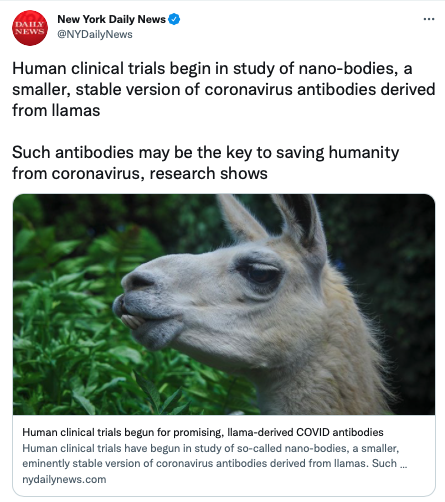The clinical trial by a Belgium-based company was ongoing, and the actual extent to which llama-derived antibodies could help COVID-19 patients remained unknown.
In addition to pharmacies, hospitals, and vaccination centers, a Belgium farm could be ground zero in the global fight against the highly contagious COVID-19 delta variant, according to news reports that surfaced in late August 2021.
Why? The farmland in Ghent, which is about 37 miles (or 60 kilometers) from Brussels, was the home of Winter — a 5-year-old llama who spends her days grazing with about 130 of her alpaca and llama friends, according to a 2020 Golden Goose Award entry dedicated to her contributions to science.
But in addition to those traits, Winter's immune system supposedly produced a special, very small antibody that, the August 2021 reports claimed, may lead to medical products that could stop the spread of SARS-CoV-2, the virus that causes the COVID-19 disease, in humans' immune systems.
In short, the underlying assertion was this: Researchers had recently injected human test subjects with a formula that included remnants of cells from a llama's blood to see if, or to what extent, those nonhuman antibodies helped combat SARS-CoV-2.
That claim was true, though we'll provide some important context to make sense of the research.
Years before the pandemic, Jason McLellan, an associate professor of molecular biosciences at the University of Austin, teamed up with Ghent-based researchers at the VIB-UGent Center for Medical Biotechnology to study camelids' antibodies and how they react to immunizations, according to the Golden Goose Award entry. ("Camelids" include camels, alpacas, and llamas.) Their goal: to determine whether, and how, llama's immune systems could produce antibodies that could be used for medical therapies.
"While humans only make one kind of antibody, made up of heavy and light protein chains arranged in a Y-shape, camelids produce two," the entry stated. "One of these is very similar to a human antibody. The other, called a single-domain antibody, VHH, or nanobody, does not have any light-chain proteins. This makes it much smaller, which is a boon to researchers."
In 2016, with the support of the National Institutes of Health, the researchers narrowed in on coronaviruses. Seven such viruses, including SARS-CoV-2, infect humans, according to the Centers for Disease Control and Prevention (CDC). Most of people will catch at least one in their lifetimes and experience cold-like symptoms. Meanwhile, a smaller population may suffer severe and sometimes fatal infections from coronaviruses such as SARS-CoV-1, which caused the 2002-2003 SARS epidemic, or MERS-CoV.
Enter Winter, who was 9 months old at the time. Researchers vaccinated her with spike proteins from SARS-CoV-1 and MERS-CoV to see how her immune system would react, according to a news release and the award entry. The NIH explained the experiment like this:
[Spike protiens] latch onto cells, then undergo a structural change that allows the virus to fuse with the cell. Once the virus enters the host cell, it can copy itself and produce more viruses. The nanobodies that the scientists harvested from the llama bloodstream and produced in the lab bound to the spike protein and prevented the virus from entering cells.
Flash forward to early 2020, the beginning of the ongoing pandemic.
The researchers immediately realized that the small llama antibodies “that could neutralize SARS would very likely also recognize the COVID-19 virus,” Xavier Saelens, the leader of the Ghent research center, told The New York Times in May 2020.
“There is still a lot of work to do to try to bring this into the clinic,” he added. “If it works, llama Winter deserves a statue.”
In other words, the team — which included Daniel Wrapp, a then-structural biologist at McLellan's lab — used Winter's antibodies engineered during the SARS-CoV-1 and MERS-CoV experiments four years earlier to see how, or if, they would bind to the spike protein of the recently discovered coronavirus, according to news reports at the time.
If so, that process would effectively block the coronavirus from infecting more healthy cells — in turn, showing the potential to protect COVID-19 patients from getting sicker.
"Initial tests indicate that the antibody blocks viruses that display this spike protein from infecting cells in culture," the researchers announced via a statement.
As a result, the Belgium center established a company, ExeVir Bio, to launch clinical trials. And, on Aug. 18, 2021, those agencies announced in a statement:
"The first subjects have been dosed in a Phase I clinical study of XVR011, its llama-derived antibody for the treatment and prevention of COVID-19."
In other words, yes, researchers indeed immunized a group of unidentified people with a formula containing the llama's antibodies to see how their immune system would respond. Those participants were chosen at random and among counterparts who received a placebo shot, according to the statement. Going forward, project leaders were prepared to administer additional doses to a "maximum of three groups of 10 healthy adult subjects" as part of the Phase I trial.
Dominique Tersago, chief medical officer of ExeVir, told Reuters that the technology could be a "game-changer." Ultimately, she said they're hoping to create an IV treatment that would be available to immune-compromised people in clinics or severely ill COVID-19 patients in hospitals.
Considering that evidence, we rate this claim "True" — with the caveat that the research was preliminary and ongoing, and the actual extent to which llama-derived antibodies could help COVID-19 patients on a grand scale remained unknown.
Sources:


